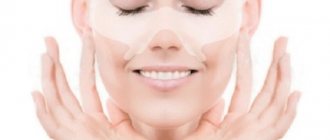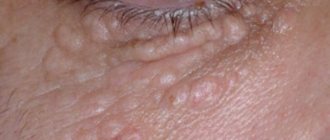Swelling under and above the eyes is a fairly common problem, especially among women. Naturally, men also suffer from this symptom, but they attach much less importance to it.
It is important to know! Swelling around the eyes is not only a cosmetic defect, but also a symptom of many diseases, including life-threatening ones.
That is why, if you notice that your eyes are swollen, the first thing you should do is not run to the cosmetics store for a new cream, but immediately visit a doctor and find out the cause of this symptom.
Puffy eyes - what is the reason?
Factors that cause swollen eyes are internal and external. External ones include lack of sleep or, on the contrary, prolonged sleep of more than 10 hours, prolonged work at the computer, stress, tears, use of low-quality cosmetics, wearing contact lenses in the wrong way. Alcohol abuse, late dinner, and drinking too much before bed also lead to swelling of the eyes and eyelids. All these reasons are not pathological. There are also internal factors that are associated with diseases of the visual organs or other body systems. In general, eyes become swollen for the following reasons:
- inflammatory eye diseases of an infectious or viral nature:
- eyelid abscess, stye, conjunctivitis, blepharitis, iridocyclitis;
- general infectious or viral diseases: influenza, ARVI;
- allergy;
- oncological eye diseases;
- circulatory disorders;
- injuries to the organs of vision, eye sockets;
- bad habits;
- pathologies of the thyroid gland, pituitary gland, blood vessels, heart, kidneys, liver, gastrointestinal tract;
- pregnancy, which often leads to water-salt imbalance.
Sometimes the cause of swelling is a congenital structural feature of the lower and upper eyelids.
Manifestation of urolithiasis
The cause of the development of urolithiasis, as a rule, is disruptions in the body's metabolic processes. Under the influence of unfavorable factors, a cell is first formed, from which the nucleus of a new element is then formed. Over time, insoluble minerals build up on it, which leads to the appearance of solid compounds.
Stones are located in the kidneys, bladder cavity or ureters. They are classified by size, color, chemical composition, structure. The stones can be small, the size of the eye of a needle, but cases of the formation of specimens weighing up to 2 kilograms are also known. Depending on the chemical impurities, stones are distinguished as white, black, yellow, reddish or gray. Solid compounds in most cases (about 70%) consist of calcium; uric acid, infected and cystine compounds are less common.
The process of stone formation is affected by the acidity level of urine. Urate compounds are formed in an acidic environment, oxalate compounds in a slightly acidic environment, and phosphate compounds in an alkaline environment. The causes of pathology depend on various factors: heredity, chronic diseases. The appearance of stones is also caused by insufficient physical activity, poor nutrition, and poor drinking habits.
In modern medicine, there are many theories explaining the processes of formation of insoluble compounds at different stages, but a complete picture is still missing. The causes of stones are not fully understood at this time.
Why does the child's eyelid and under the eyes suddenly swell?
It is not entirely correct to divide the causes of swelling under the eyes into “children” and “adults”. However, there are more common ones:
- Injuries. This is the most common reason why a child's eyes become swollen. Children spend most of their time playing; they can accidentally fall or fight if they don’t share something. Contusions are usually accompanied by bruises.
- A bite of an insect. The area affected by an insect (mosquito, gadfly, bedbug, etc.) usually itches and turns red.
- Phlegmon of the orbit is a purulent inflammation that manifests itself in symptoms such as nausea, vomiting, migraine, blurred vision, eyelid hyperemia, pain when moving the eyes.
- Abscess of the lacrimal sac. In this pathological condition, pus and a large amount of tear fluid are released from the eyes. The eyelids become swollen and red. The child instinctively rubs them with his hands, which causes the swelling to increase and cause even more discomfort.
- Quincke's edema is an allergic disease that causes severe swelling. They usually occur on the legs, arms and face. The color of the skin does not change, there is no itching. Sometimes the patient experiences nausea and vomiting.
Clinical picture
If morning swelling on the face and body is caused by problems with the urinary organs, then in combination with puffiness the following symptoms will appear:
- Symmetrical swelling. So, in case of problems with the kidneys, swelling will be equal throughout the body, while problems with the maxillary sinuses or blood vessels will produce swelling only from the side of the pathological process (located thrombosed vessel or inflamed maxillary sinus).
- Mobility of swelling. That is, when changing body position, it will go down to the legs.
- Rapid reduction of swelling during kidney treatment. In the case of other causes of puffiness, the swelling subsides more slowly.
- Pain in the lumbar region. However, it may not always manifest itself, especially if the process occurs in a chronic form.
- Change in diuresis. A decrease or increase in the urge to go to the toilet also indicates problems with the urinary system.
- Weakness and fatigue. They may be signs of the initial stage of intoxication of the body.
- Headache. They indicate azotemia (saturation of the body with protein breakdown products).
- High blood pressure. Moreover, against the background of renal pathology, it is not corrected by medications.
The upper eyelid is swollen: causes
Both eyelids or just the upper eyelid may swell. Usually one of them is affected by allergies and inflammation. In this case, the cause is usually inflammatory diseases of internal organs. Often the upper eyelid swells due to age-related physiological changes. The thin membrane located between the subcutaneous tissue and the skin of the eyelid cannot retain fluid. This leads to swelling of the eyelid.
Decongestant pharmaceutical drugs
Active components act directly on the problem, so such products are more effective.
It is recommended that you consult your doctor before using a specific decongestant. The specialist will make a diagnosis and then prescribe the necessary medications and creams.
The following pharmaceutical products have an anti-edematous effect:
- Cream “IDEALIA” from VICHY (anti-edematous effect, the cream eliminates dark circles under the eyes, gently soothes the skin, effectively eliminates signs of fatigue).
- Cream “AGE EYE COMPLEX” from SKINCEUTICALS (eliminates swelling, eliminates dark circles from the skin).
- Garnier Anti-Aging Cream (recommended for the care of the skin around the eyes for women over 45 years old).
What causes the lower eyelid to swell?
As a rule, with such swelling, bags appear under the eyes and they usually appear on both sides. The reasons for this may be the following:
Poor lifestyle, unbalanced diet, injuries, use of low-quality cosmetics, lack of hygiene. These factors are isolated and are not associated with diseases. Diseases of blood vessels, kidneys, heart, thyroid gland, allergies, fatty hernia, congenital and age-related features of the structure of the eyes.
Swelling that does not go away during the day and is not accompanied by any symptoms usually indicates the presence of a fatty hernia. They most often occur in women over 35 and are associated with aging, which causes the skin to become less elastic.
The causes of swelling under the eyes can be listed further. Basically, this symptom is not dangerous. In the morning a person wakes up and sees that his eye (or both) is swollen, and by evening the swelling goes away on its own. Men usually do not pay attention to such a cosmetic defect. It mainly bothers women who try to disguise it with cosmetics. Sometimes it is necessary to consult a doctor to find out the exact cause of swelling. The need for this arises with chronic swelling.
conclusions
Thus, it is very difficult to quickly find out why a person experiences swelling around the eyes. The first thing to do is to analyze your lifestyle and diet to understand whether you have factors that can cause harmless physiological swelling. If such are found, do everything to get rid of them, and special cosmetic care products, massage, gymnastics, and cold compresses will help you do this. If the swelling is constant or pronounced, or additional pathological symptoms are observed, immediately seek help from a doctor. The specialist will prescribe additional examinations and, according to the diagnosis, draw up an individual treatment program. The sooner you identify
Eyelids and eyes are swollen: what to do?
The method of eliminating this symptom depends on the cause of its occurrence. If this is an infectious ophthalmological disease, eye drops, ointments and gels are prescribed. When a disease of the internal organs leads to swelling of the eyes, one has to take steroids, anti-allergenic drugs and drugs that improve blood circulation.
In any case, the underlying pathology is always treated.
For eye pathologies accompanied by itching, hyperemia and burning in the eyes, the following drops are prescribed:
- "Sulfacyl". It helps with blepharitis and conjunctivitis.
- "Albucid" - drops with an antibacterial effect, prescribed for conjunctivitis and keratitis.
- "Floxal" is an antimicrobial drug that is most often used for corneal ulcers, eye injuries, and barley.
- "Allergodil" is an ophthalmic solution that relieves itching, redness and swelling.
You cannot use medications without a prescription. Puffiness of the eyelids, bags and bruises under the eyes are quite common symptoms characteristic of many diseases. You will not be able to make a diagnosis on your own.
Using the drug for other purposes may lead to complications.
Ointments and gels are used in addition to drops. Tetracycline, hydrocortisone, heparin or oxolinic ointment helps eliminate swelling under the eyes and on the eyelids.
Kidney treatment
One of the most characteristic signs of diseases of the urinary system is the appearance of edema. Timely treatment quickly relieves this symptom. It is a mistake to believe that at this stage the disease has already receded. The patient should continue therapy until complete recovery to avoid relapses.
Kidney disease usually does not require surgery. Treatment is prescribed by a doctor depending on the patient’s condition. The standard methodology includes several points.
- The patient must strictly observe bed rest for at least 2 weeks.
- Take diuretics. Diuretics are aimed at reducing fluid content in the body, as a result, pathogenic flora is washed out from the affected organs.
- Take antibiotics. The product helps suppress pathogenic bacteria and prevents the development of inflammation in the kidneys or other organs of the genitourinary system.
- Take anticoagulants. Substances that affect blood clotting are prescribed for renal vein thrombosis.
- Follow a diet. In case of kidney disease, salt is almost completely excluded from the patient’s diet as a product that contributes to the accumulation of fluid in the body. The amount of protein consumed is limited depending on the stage of the disease.
What happens next largely depends on the patient himself. If you strictly follow the doctor’s instructions, the prognosis for recovery is favorable.
Folk remedies for relieving swelling
So-called traditional medicine can be used in the treatment of infectious diseases, but after consultation with a specialist. You can take note of the following recipes:
- Green tea. Brew it, cool it, pour it into ice trays and put it in the freezer. Apply ice cubes to your eyelids every morning for 1-2 minutes. Brewed bags can be used as lotions. They should be applied to the eyelids for 10-15 minutes.
- Grated potatoes. Peel it raw and grate it on a fine grater. After that, put it in cheesecloth and squeeze out the juice. You need to blot the cotton wool in it and apply it to your closed eyes.
- Oak bark. It is infused in hot water. After this, strain the liquid and use it to make lotions. Instead of oak bark, you can make infusions from various herbs, such as chamomile.
Face masks are made from vegetables, sour cream, fruits, etc. There are special masks that are sold in pharmacies. If you have time and sufficient financial resources, contact a cosmetologist. Such measures allow you to eliminate swelling quickly, but, of course, do not affect the reasons that lead to its appearance.
Chronic pyelonephritis
Among the pathologies of the urinary system, chronic pyelonephritis is common. In essence, it is an inflammatory process affecting kidney tissue. Its cause is representatives of pathogenic microflora.
Inflammation is caused by staphylococci, streptococci, E. coli and other types of microbes. Pyelonephritis enters the “chronic” category after the acute stage. The disease can hide in the body for a long time, and rarely reveals itself with pronounced symptoms. It is important to remember that diagnosing the disease is difficult, but the consequences can be extremely serious.
Gymnastics for the eyes
As noted earlier, eyes can become swollen as a result of constant computer work. If your work involves a lot of visual stress, you should periodically do eye exercises. It helps improve blood circulation, which promotes lymph outflow. You need to perform gymnastics 2-3 times daily. Otherwise, it will not have any effect. Typically, experts recommend the following exercises:
- closing your eyes and sharply opening your eyes for 10-15 seconds;
- turns to the sides, circular movements of the eyes clockwise and counterclockwise;
- frequent blinking for 20-30 seconds.
Exercises can be performed right at your workplace. They don't take much time. In addition to exercise, massage your eyelids. The upper eyelids and skin under the eyes should be massaged with your fingertips in light circular movements. This helps improve blood circulation.
Try not to self-medicate. It may make the situation worse. Do not leave such a symptom as swelling of the eyes and eyelids unattended, especially if other unpleasant signs develop in parallel, which may indicate an incipient pathology.
Prevention
Following simple recommendations will help minimize the risk of swelling. Avoid negative factors and your eyes will be healthy:
- Get at least eight hours of sleep. Adequate sleep is important for the health of the whole body;
- Consume carbonated drinks and coffee to a minimum;
- Try to eliminate salty foods from your diet;
- Avoid strong gusts of wind and pillars of dust;
- Minimize contact with the irritant, or better yet eliminate it altogether;
- Observe the rules of personal hygiene;
- Do not communicate with people suffering from ophthalmological diseases of infectious origin;
- Take care of your nervous system! Try to cry less and avoid stressful situations;
- Before going outside, apply a cream with a UV filter to the skin around the eyes;
- Do not abuse alcoholic beverages.
| If you have to work at a computer for a long time, take breaks every half hour. |











